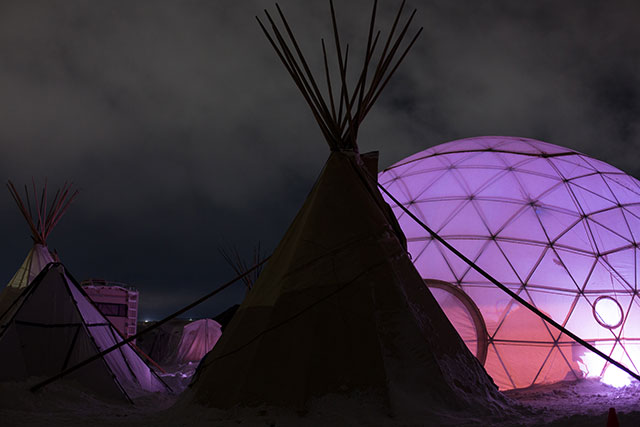
My chest tightened and my thoughts scurried on the morning of November 26 as we pulled onto the highway on our two-day journey to Standing Rock, North Dakota. Was this anxiety? I’m not usually an anxious person but I had no idea what to expect in the next week. Bad Sunday had just happened, when police shot people in the head with rubber bullets, tear-gassed them and fired water cannons on folks in 20-degree weather. Facebook was a stream of fear-inducing accounts about what was going on. But the calling for my father Mike, our friend Noel and myself to go see for ourselves and hopefully contribute was greater. We carried donated grass-fed beef from the Lazy R Ranch, cash from several friends and a large bag of winter coats — all stuffed into dad’s old Toyota Tercel.
 (Photo: Tegra Stone Nuess Photography)
(Photo: Tegra Stone Nuess Photography)
As soon as we arrived at Oceti Sakowin Camp, my anxiety lifted and the only feeling I had was excitement. ‘Welcome home!’ said the greeter at the gate. We drove slowly down Flag Road into camp and were met with smiles and waves. We set up our camp in the first winter blizzard and began to wander. We soon came upon a truck rolling to a stop. A woman emerged into the roaring snow, raised her arms to the sky and began whooping in obvious joy. She grinned at us as we approached. “I’m back!” she sang into the wind. Noel gave her a congratulatory hug and we celebrated the return of the Colville Confederated Tribe’s Patty Sam Porter. It was only later that we learned of her courageous 250-mile paddle from the headwaters of the Missouri. And so we began an amazing week with 5000+ peaceful, prayerful and wonderfully fun people.
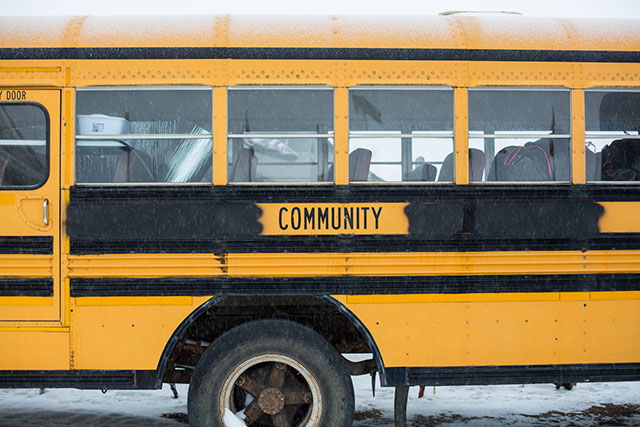 (Photo: Tegra Stone Nuess Photography)
(Photo: Tegra Stone Nuess Photography)
The community of this incredible place is what struck me the most. I hadn’t realized how much I missed this sense of camaraderie and connection in my world. Here people take care of each other and consciously practice calling in instead of calling out when differences are discovered. It felt like the way we’re supposed to live — hopefully it’s the future of our world.
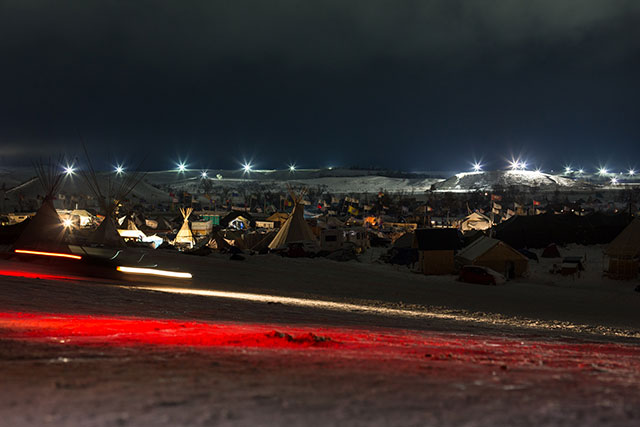 (Photo: Tegra Stone Nuess Photography)
(Photo: Tegra Stone Nuess Photography)
Most media only shows 10% of what Standing Rock is about — police and contractors attacking nonviolent protectors. That’s important, but “We’re Missing 90% of the Dakota Access Pipeline Story,” which is a celebration of both uniqueness and unity among tribes, cultures and races who respect our planetary home and are here to seek a sustainable future for all. So dad and I decided to bring you personal stories from a few of the many people we met during our brief stay, moments people shared with us, whose stories spoke to us and we hope they speak to you, too.
Magdelion Moondrop’s Story
The Compassionate Power of the Feminine.
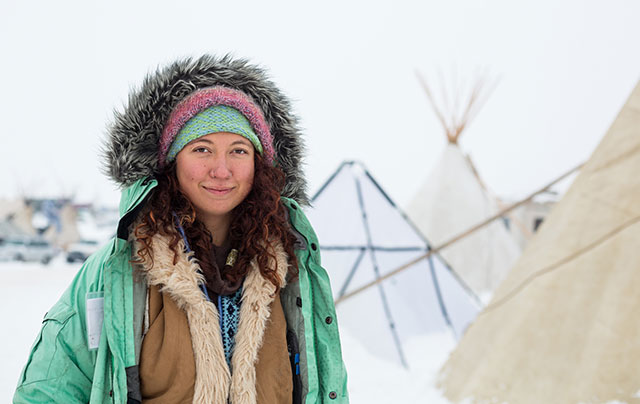 (Photo: Tegra Stone Nuess Photography)
(Photo: Tegra Stone Nuess Photography)
Hailing from Colorado, Moondrop is a quiet, young woman who is quick to smile and give you a hug. In her calm, peaceful voice, she told me the story of the women-led, silent action on the police-blockaded bridge on Sunday November 27th, seven days after Bad Sunday. When she arrived at the Oceti Sakowin Camp, she felt that many women shared her desire for a women’s group. Having been a part of many women-focused circles before, she helped call a meeting together of about 40 women, which grew to a daily gathering. They created a safe place for women to share their stories, their challenges and to discuss the goal of a women-led action to cross the Missouri River.
Led by Cheryl Angel, Lyla June and Starhawk, three powerful and unitive indigenous leaders, the group gathered on the morning of the 27th to prepare their bodies and minds. Moondrop said the sweat lodge that morning cleared their spirits as they cried and released, providing room for strength and prayer. Then 100 or so women and men trained on how to remain silent and signal to each other. Starhawk taught them to stay grounded in their center and to do so by imagining what they stand for here. Moondrop was amazed at how completely unmovable they became when they stood for what they believe in. They drilled on their formation to protect the indigenous leaders as they performed their ceremonies.
Then it was time, and the women silently formed into a steam that would pass through the camps and onto the bridge. Moondrop said, “it was so powerful to feel the men so willing to step back and support us and stand behind us.” People silently joined them as they walked through both Rosebud and Oceti camps and the stream of women became a river. They met resistance from the council of young men who weren’t aware of what was happening, but Cheryl Angel had approval from the grandma elder, and ‘the feminine walked forth’, continuing. Another dam of male veterans resisted the woman again at the bridge, but they looked them silently in the eyes and conveyed that it was time to let the women lead, to trust them. LaDonna, the woman who started Standing Rock’s opposition to DAPL, joined at this time and Moondrop knew they were now unstoppable. The veterans acquiesced and helped by asking the Army Corps if the women could come to the front and do a ceremony. With thousands of people behind them in total silence, the elder women walked across the bridge through the former war zone, through broken glass, shells, dried blood and teargas-soaked clothing; to the edge of the razor wire where they knelt. They offered forgiveness, wept for the atrocities, wept for their ancestors, prayed for the hearts of the police, and begged for their compassion. “It was the most beautiful moment of my life to witness these women being so vulnerable in the face of armed guards with guns and tanks on the other side of a razor wire fence and to witness them so open and humble and weak, but so strong in their vulnerability. “It was like a radiative, thick blanket of peace washing over everything,” Moondrop recounted. A police officer offered to safely guide the elders down to the river to perform a water ceremony. It was the first time anyone had been allowed on the other side of the river. Afterwards, the supporting men back on the hill parted for the returning river of women who silently lead everyone back to camp. Moondrop felt like it was the rise of a matriarchy and the rise of women finding their voice and their power to create a peaceful outcome here. She could feel everyone’s thankfulness as they reentered camp. As she finished her story, I was struck by how much sense it makes to enact change in this peaceful, compassionate and feminine way. When fear is released, walls can come down and understanding can take place. I myself am extremely thankful to these women for leading the charge.
Grandma Diane’s Story
I’m doing this for my Grandchildren…
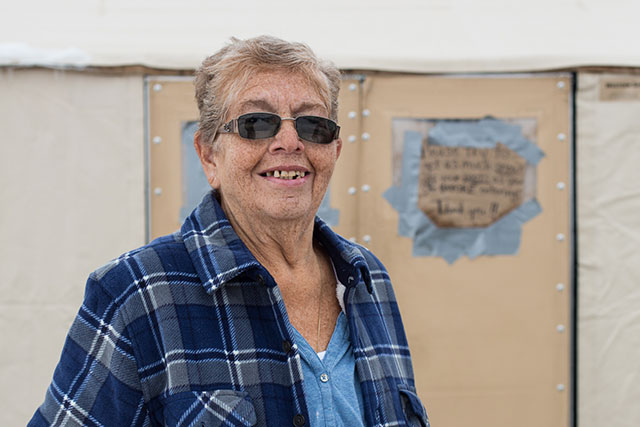 (Photo: Tegra Stone Nuess Photography)
(Photo: Tegra Stone Nuess Photography)
Everyone knows Diane as Grandma. She greets them with a big hug and she’s one of those women that feel like your own grandmother as soon as you meet them. Every day she runs the California Kitchen, creating delicious, healthy food for the camp. Her tribe, the Bishop Paiute, along with the Lone Pine Paiute Tribe and the Big Pine Tribe (all from Owens Valley near Bishop, CA) collaborated to set up one of several communal kitchens. Her original kitchen tent grew to three large military tents comprised of a dinning tent, a storage tent lined with shelves stacked high with donated food and a cooking tent full of volunteers prepping every meal. Diane loves to cook, and when back home she often cooks dinner for her large family. She also caters tribal community events, serving 500-700 people. So this is a perfect fit.
When I asked her why she came to Standing Rock, she said there were two main reasons. The first is that they have been fighting their own water battle with Los Angeles for years. The 1939 land exchange took 60,000 acres away from her tribe, taking all their water with it. The tribes filed a lawsuit against LA in 1998 that still hasn’t been resolved. “Our tribe is known as the water protectors. So when the cry went out, we knew we had to come.” She hopes this will bring light to other tribes’ battles for land and water around the country.
The second reason is that her heart was pulling her here. She has 15 grandchildren and 5 great grandchildren and she wants them to have a future with clean water to drink. When she was about 9 or 10 years old her grandfather told her that there would be a cause that would bring all the native peoples together, as well as the rest of the world, and we would have to fight for something very important. As soon as she arrived at Standing Rock she felt his whole spirit and knew he’d brought her here. She said, “I’m doing this for my grandchildren and my future.” Thank you so much, Grandma.
Sylvia’s Story
How Compassionate Solidarity Dissolved my Fear.
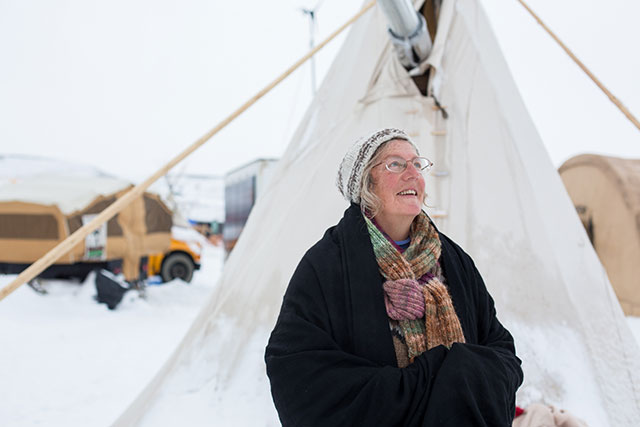 (Photo: Tegra Stone Nuess Photography)
(Photo: Tegra Stone Nuess Photography)
Sylvia is a white woman who came to stand in solidarity with her indigenous sisters and brothers at Standing Rock, to help protect Mother Earth. She was arrested and caged inside a chain linked ‘dog kennel’ with several other women. Her terror grew as she sat on the cold ground thinking about what would come: degrading searches, trumped up felony charges, the expensive logistics of long-distance court appearances.
Then a woman came and sat close, facing her. “I was scared and she could see it. ‘You have to go somewhere inside yourself,’ the woman said. Then she began to sing.” Sylvia did not understand the words of the woman’s native song but she felt it begin to soothe her. She felt all the women quietly, soothingly with her. She began to feel at ease. Everyone seemed to relax and feel at ease. And then, just as the last note of the song faded, a loud voice erupted from the speaker system, summoning her by name.
Suddenly all the women simultaneously reacted with hoots of laughter. Sylvia arose and walked to her fate, at ease in some calm place inside herself.
Wanda’s Story
How the Police Blockade is Affecting Cannon Ball.
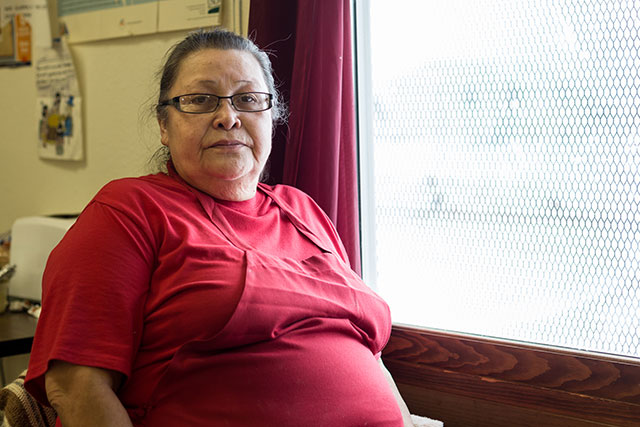 (Photo: Tegra Stone Nuess Photography)
(Photo: Tegra Stone Nuess Photography)
Wanda lives in the Cannon Ball district of the Standing Rock Reservation. She cooks in the community center and is thankful for all the donations of food and clothing that have come to their community since the DAPL opposition began. However, the Army Corps’ closure of Highway 1806 has negatively impacted their town. 1806 is the fastest and most direct route from the city of Bismarck south to Cannon Ball, which sits just a couple miles south of the police-blockaded bridge and the Oceti Sakowin Camp.
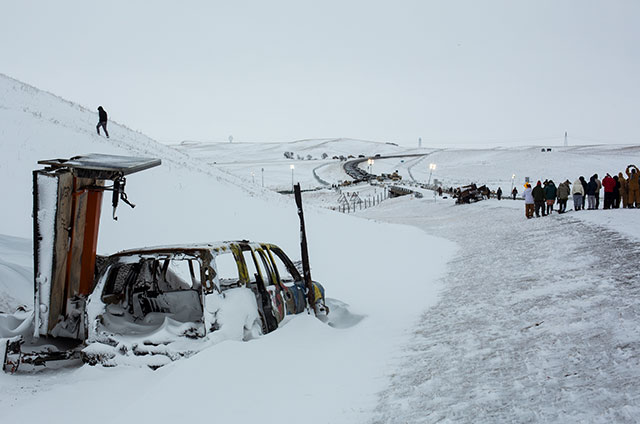 (Photo: Tegra Stone Nuess Photography)
(Photo: Tegra Stone Nuess Photography)
On the night of November 28th, just as the three-day blizzard started to hit, Wanda’s son had one of his bad seizures. He fell outside the community center. Friends found him and hurried to protect him from the 30 mile-an-hour gusts. The ambulance finally arrived and took him to Sanford Hospital in Bismarck. Wanda followed in her car for a harrowing 3 hour, a trip that normally takes 45 min in normal weather on 1806. But the 1806 closure forced her to take the longer Highway 24-to-Highway 6 route in a blizzard, at night with icy roads. “It was scary, but I had to get up there to be with my son.” Whether or not it was deliberate, the roads weren’t plowed until she got close to Bismarck.
She implores the police to please open 1806 because the closure makes it hard for the people who live here. She was also concerned for those who live in Bismarck and must travel the longer route for work. Her son is now back home and doing well, but Wanda hopes the road will open soon, for everyone’s safety.
Raymond’s Story
“Our ancestors make things happen.”
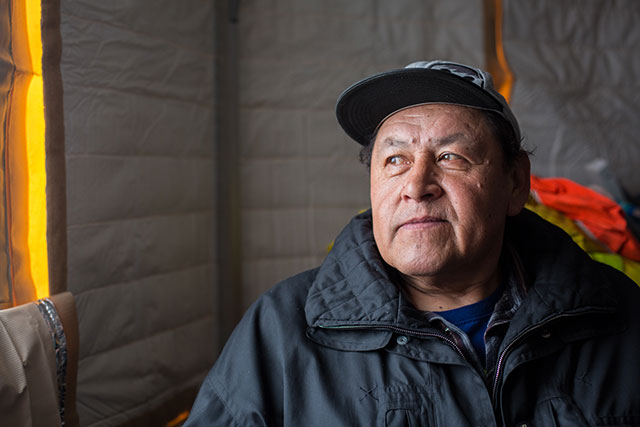 (Photo: Tegra Stone Nuess Photography)
(Photo: Tegra Stone Nuess Photography)
Raymond Kingfisher is an easygoing, friendly and humorous person of the Northern Cheyenne Tribe in Montana who now lives in Western Washington State. He is a regular speaker at camp meetings who has a knack for addressing sensitive, serious and sacred issues before a large group and then switching it up with a subtle comment that restores laughter and lightness to a somber audience.
This was his third stay at Standing Rock. He travels between stays to raise funds and collect supplies for the water protectors here. This third time he pulled a canoe down the Missouri with a Puyallup Canoe Family, together with The Colville Tribes, the Coeur d’Alene Tribe and others as far away as Alaska. Their group of about 40 people pulled past the Sacred Stones — rocks ground round and polished by a whirlpool that lies at the confluence of the Cannon Ball and Missouri Rivers. At one point they were forced ashore in a massive, life-threatening (See Patty Sam Porter’s Story) hailstorm and upon the land of local North Dakotans, who sheltered them until the storm passed. They finally arrived at Standing Rock, a long chain of canoes and dug outs roped together end-to-end, where their group was received by song. But, laughed Raymond, their greeters had to be told the custom was to receive each vessel with a welcoming song. And then everyone laughed and several welcoming songs were sung that day.
Raymond worries about supplies being cut off or confiscated and suppliers being ticketed, fined or arrested. “It’s my third time back bringing supplies. I’m protecting water for not just native people but for people from all walks of life, and for future generations. That’s why I’m here.”
***
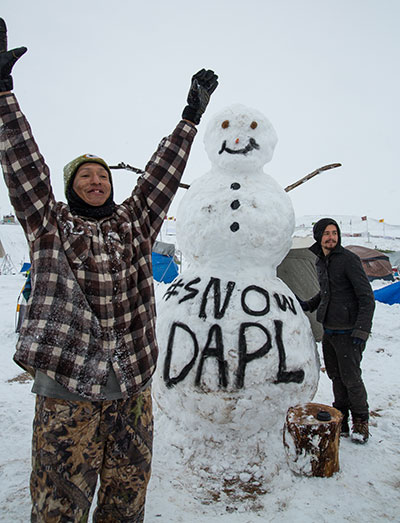 (Photo: Tegra Stone Nuess Photography)Perhaps Robert F. Kennedy was right when he recently came here and said that this peaceful convergence at Standing Rock “is kinda the spear tip of the front line in the battle over the transition from an old energy economy to a new energy economy. And we know that we have to do that. … Today wind and solar are much cheaper. … so the only way the carbon cronies can keep their domination of the marketplace is by constructing a lot of infrastructure, so that … the people who invested … the Citibanks, the pension funds … now have to see oil going through that pipeline for years … long after any justification for oil is long gone.”
(Photo: Tegra Stone Nuess Photography)Perhaps Robert F. Kennedy was right when he recently came here and said that this peaceful convergence at Standing Rock “is kinda the spear tip of the front line in the battle over the transition from an old energy economy to a new energy economy. And we know that we have to do that. … Today wind and solar are much cheaper. … so the only way the carbon cronies can keep their domination of the marketplace is by constructing a lot of infrastructure, so that … the people who invested … the Citibanks, the pension funds … now have to see oil going through that pipeline for years … long after any justification for oil is long gone.”
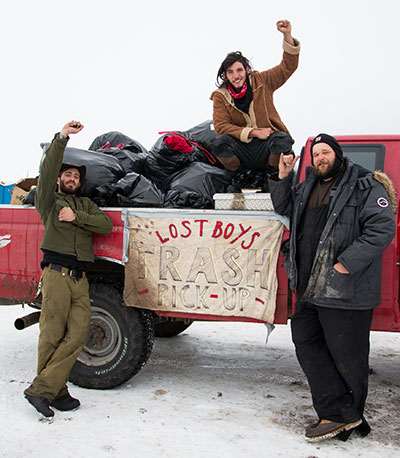 (Photo: Tegra Stone Nuess Photography)The water protectors of Standing Rock know how foolish that locked-in investment would be, how grievously it would harm not only water but also all of the exquisitely interdependent ecological processes of Mother Earth. They know a clean, sustainable and abundant future for all is possible, quickly available, and so urgently necessary. May the spear tip shine brightly and swiftly pierce all our hearts.
(Photo: Tegra Stone Nuess Photography)The water protectors of Standing Rock know how foolish that locked-in investment would be, how grievously it would harm not only water but also all of the exquisitely interdependent ecological processes of Mother Earth. They know a clean, sustainable and abundant future for all is possible, quickly available, and so urgently necessary. May the spear tip shine brightly and swiftly pierce all our hearts.
Our most important fundraising appeal of the year
December is the most critical time of year for Truthout, because our nonprofit news is funded almost entirely by individual donations from readers like you. So before you navigate away, we ask that you take just a second to support Truthout with a tax-deductible donation.
This year is a little different. We are up against a far-reaching, wide-scale attack on press freedom coming from the Trump administration. 2025 was a year of frightening censorship, news industry corporate consolidation, and worsening financial conditions for progressive nonprofits across the board.
We can only resist Trump’s agenda by cultivating a strong base of support. The right-wing mediasphere is funded comfortably by billionaire owners and venture capitalist philanthropists. At Truthout, we have you.
We’ve set an ambitious target for our year-end campaign — a goal of $125,000 to keep up our fight against authoritarianism in 2026. Please take a meaningful action in this fight: make a one-time or monthly donation to Truthout before December 31. If you have the means, please dig deep.